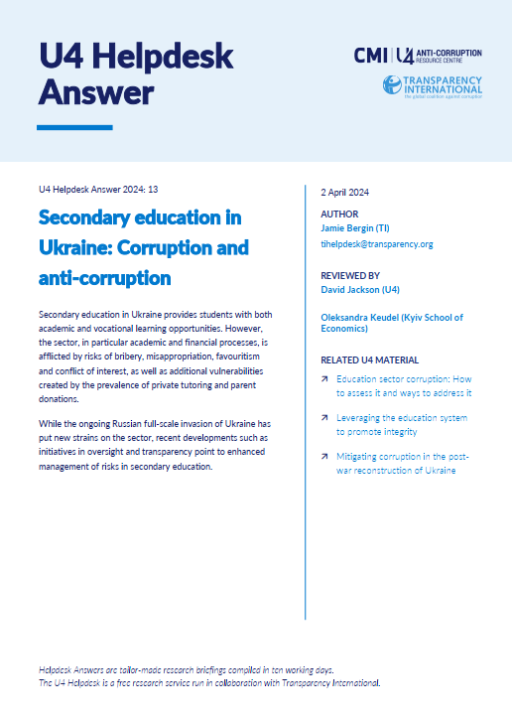
This Anti-Corruption Helpdesk brief was produced in response to a query from a U4 Partner Agency. The U4 Helpdesk is operated by Transparency International in collaboration with the U4 Anti-Corruption Resource Centre based at the Chr. Michelsen Institute.
Query
Please provide an analysis of corruption risks in the secondary education system and secondary education school management in Ukraine, particularly from the perspective of academic integrity and resource management.
Summary
Secondary education in Ukraine provides students with both academic and vocational learning opportunities. However, the sector, in particular academic and financial processes, is afflicted by risks of bribery, misappropriation, favouritism and conflict of interest, as well as additional vulnerabilities created by the prevalence of private tutoring and parent donations. While the ongoing Russian full-scale invasion of Ukraine has put new strains on the sector, recent developments such as initiatives in oversight and transparency point to enhanced management of risks in secondary education.
Main points
— As in other countries, the high stakes of education in combination with weak oversight have contributed to the existence and normalisation of certain corruption practices in Ukraine’s secondary education system.
— The Russian invasion launched in 2022 has both created new issues and exacerbated existing vulnerabilities.
— The fairness of academic processes in Ukrainian secondary education, especially admission, exam grading and supplementary tutoring, may be distorted by bribery and favouritism.
— Furthermore, aspects of resource management, such as procurement tendering and the spending of parental donations, are vulnerable to misappropriation and conflict of interest. Further, there are some gaps in human resource processes, such as the appointment of heads of secondary education institutions, that can enable favouritism.
— Despite this, recently there have been many positive developments in Ukraine addressing corruption in the education sector, such as the adoption of risk management approaches and enhanced transparency measures.
— These have the potential to be scaled up with support from the international community, as well as civil society and local stakeholders.
Contents
- Introduction
- Secondary education in Ukraine
- Structure
- Actors, legislation and policies
- Funding and expenditure
- Russian full-scale invasion
- Corruption within secondary education in Ukraine
- Levels of corruption
- Risk areas
- Anti-corruption measures for secondary education in Ukraine
- Risk management
- Transparency
- Accountability
- External checks
- Civil society involvement
- References
Authors
Jamie Bergin (TI)
Reviewed by
David Jackson (U4)
Oleksandra Keudel (Kyiv School of Economics)
Date
02/04/2024
Tags
 Download PDF
Download PDF
